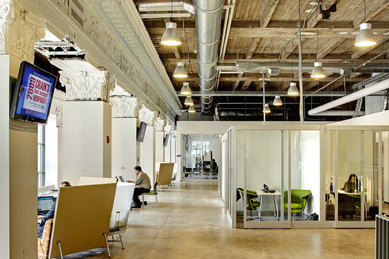Workplace Trends
The evolving workplace.
Many factors are changing the nature of work, and work behaviors. No longer is the office the only place where work gets done. Rapid advances in technology, globalization and demographic shifts are all fundamentally changing the workplace. So, what is Workplace of the Future? At SmithGroup, we’ve outlined several trends that impact the way organizations view space.
Nature of Work & Globalization
SmithGroup holds an annual client advisory roundtable where we discuss organizational hot buttons, trends and the future of the workplace with a select group of participants. Our contributors offer diverse backgrounds, products and company structure, but all share the same general feeling that the nature of work and business models have dramatically changed during the last five to eight years. Add to that, most companies have multiple locations across the United States and many have a presence in the global marketplace. The challenge remains how to design and manage space that is consistent with a firm brand, yet also reflects a local culture.
Technology Driving Change
Flexibility in the office is pivotal. Office buildings are static structures with an expected lifecycle of fifty-plus years. Interior environments have a shorter lifespan, turning over about every 15 years or so, some sooner with short lease terms. Compare that to the fluid and rapid pace of technological advancements where, on average, new innovations are being introduced every 18 months. The demand for flexible and agile workspace is high, and office space needs to accommodate this evolution. As technology continues to untether workers from their personal work environments, we see a trend for an equal need to create spaces that reinforce personal connections within an organization, and the need to be social and collaborative.
Generational Differences
Demographics are yet another shift in the marketplace. Babyboomers – those individuals born between 1946-1964 are still the largest population in the workforce today, but research shows that by 2016, the Millenials, those born between 1982-2002 coming of age during and after the turn of the millennium, will be the majority of the work force. In the US alone, there will be 80 million members. Why does this matter? The younger generation brings different habits, expectations and attitudes to the workplace that will influence the design of the office environment, as well as how the office will be used to support the work. They are the digital natives, comfortable with technology from an early age and tech-savvy. They expect a healthy, green environment with ampleaccess to natural daylight; their company to ‘do the right thing’. Studies have shown that happy and healthy employees lead to better workplace satisfaction and improved effectiveness on the job.
Reappropriation of space
We call it ME vs. WE space. Today’s work environments need to offer choice and balance. There are times when people need to work in the office to collaborate and interact. There are other times when individuals need focus and limited disruption. SmithGroupJJR get this! Our office design strategies offer options for employees to work. A place where people can concentrate; where they can collaborate; and an office that supports the exchange of ideas to innovate and build culture.
